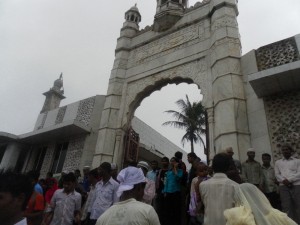 Our plot points may differ but our story is the same: the incomprehensible is attributable to the Other, the Eternal, the Holy, the Unknowable… and so we’d best pay our respects.
Our plot points may differ but our story is the same: the incomprehensible is attributable to the Other, the Eternal, the Holy, the Unknowable… and so we’d best pay our respects.
From Hindus to Jews to Catholics to Muslims, all of whose houses of worship I visited in the past three days, this is the meaning that I’ve derived. Incidentally, meaning-making is another commonality that binds us all, this storytelling drive that provokes the fabrication of our superficially dissimilar, conceptually similar accounts in the first place.
On Sunday, I contemplated the ancient carvings of Hindu gods and illustrated miniatures of spiritual tales cached within the Chhatrapati Shivaji Maharaj Vastu Sangrahalay(formerly known as the Prince of Wales Museum). I walked alone from Kenneseth Eliyahoo Synagogue to St. Thomas Cathedral, the streets between and rooms within nearly deserted on this predominantly Hindu/Muslim nation’s day of rest. That evening, the clanging of a Hindu temple’s bell disturbed my small talk with a stranger – an Iranian lawyer/PhD, liberal Muslim, would-be cassanova, who said that he and most of his countrymen had no beef with Israel.
On Monday, I trekked across a monsoon-swept footbridge to the Haji Ali Mosque, where the fallen prophet’s body legendarily washed up following his pilgrimage to Mecca. There, a Muslim woman accepted my donation for young, non-Muslim cancer patients and took it upon herself to escort me into the mosque. She handed me a rose petal, the eating of which, she said, would cure all that ails me. I shook her hand goodbye and revealed my religious heritage, drawing her laughter and remark that Jews and Muslims don’t often work together. “But we all care about children,” I said. From there, I puddle-plowed to Mahalaxmi Temple, a gem whose depth, breadth, norms, and geography I hadn’t yet grasped when I had first visited four weeks earlier. Once again, I looked upon Ganesh, remover of obstacles, god of new beginnings, and thought about all that had transpired in the past month, the prayers that had been answered, the issues that still preyed.
Imbued with adventure, I splashed on to unearth shrines of a different nature — first a children’s toy/crafts store, then an expansive corporate bookstore. Omens? Affirmations?
On Tuesday, I stumbled across another church, a few more mosques, another temple. So many spaces, in such close proximity, all established for similar purposes. Rising up from, towering above the commercial, there was the spiritual. I don’t mean to set up a false dichotomy – the spiritual is often commercialized and/or otherwise tied to mercenary matters. After all, the temple’s new roof won’t pay for itself, and dealing with infidels requires resources, doesn’t it? But my argument of universality remains intact. Across people and time, despite other competing interests, there has been this preoccupation with what it all means and how to stay safe. Similarly, religions and religious adherents have always indulged in morally questionable activities, often in the name of their faith, from fraud to violence – last week’s (allegedly) Muslim-designed terror against this Hindu city attests to that. Our common depravity irrefutably supports our humanity.
Monday night, an Indian Catholic woman named Rose offered me a photograph of an Indian-based Mother Mary statue. Something had just told her, she said, to get that photo copied. Her eyes widened and she pumped my hand with excitement when I answered her query about my religious identity. She told me about visiting a synagogue and Chabad House, participating in a Passover seder, talking with a rebbe. Rose asked that, when I’m back in the States, I light a candle for her passionately desired visit to Israel. I agreed, thinking about how to slide that into my (lapsed) religious practice, into a wider religion that doesn’t really light candles like that. Rose was under the impression that it does –she’d lit a menorah candle once, she disclosed proudly.
I climbed the steps to our eighth floor apartment, to send up my tofu/green pepper/basil offering to the deities of nutrition and drink in Mad Men‘s depiction of 1960’s American WASPs’ struggles with right and wrong.
We are all seekers. Always have been, always will be.

